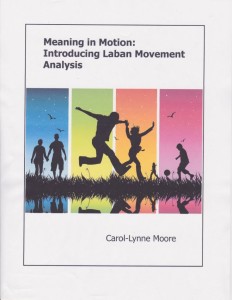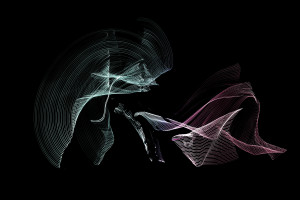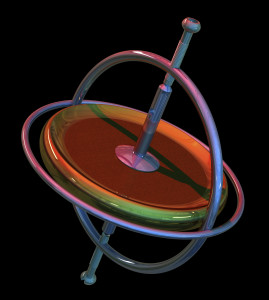 “Meaning in Motion is one of the few, if not the only, contemporary texts to integrate historical, theoretical, and creative frameworks for understanding and studying Laban Movement Analysis,” writes Dr. Andrea Harris, University of Wisconsin, Madison.
“Meaning in Motion is one of the few, if not the only, contemporary texts to integrate historical, theoretical, and creative frameworks for understanding and studying Laban Movement Analysis,” writes Dr. Andrea Harris, University of Wisconsin, Madison.
Dr. Harris has been using the text for several years now. Her comment highlights key features of the book. For example, Part 1 – History and Development of Laban Movement Analysis – discusses Laban’s career, the contributions of Irmgard Bartenieff and many others who have added to the Laban legacy.
Theory is covered with sections on Body, Effort, Space, Shape, and Movement Harmony. Each of these sections incorporate Creative Explorations for use in the studio during class time or for individual study.
The book is richly illustrated with photographs, charts, and effort and space phrases. Five different appendices provide additional material for study. These include bibliographies of various works by Laban, Bartenieff, and other major applications of Laban theory, along with more advanced space and effort sequences, and a section on relationship. As Harris notes, “ I like that the polar triangles, girdles, axis, A and B scales are in the appendix, in case an instructor would want to incorporate them.”
She adds, “I have always wished for more information about Relationship (Appendix E). I appreciate that you’ve fleshed out how the various Laban communities conceptualize relationship.”
In the next blog, learn how Dr. Nancy Beardall uses Meaning in Motion in two programs at Lesley University.

 I didn’t start out to write an introductory Laban Movement Analysis text. It began as a compilation of teaching materials I’ve developed over the last three decades, teaching in Certificate Programs in New York, Chicago, Seattle, Los Angeles, Salt Lake City, Berlin, The Netherlands, and England.
I didn’t start out to write an introductory Laban Movement Analysis text. It began as a compilation of teaching materials I’ve developed over the last three decades, teaching in Certificate Programs in New York, Chicago, Seattle, Los Angeles, Salt Lake City, Berlin, The Netherlands, and England. In my discussion of Movement Pattern Analysis (MPA) at the public lecture session in Montreal, I aimed to demonstrate how knowledge from the field of dance became relevant and valued in the business world.
In my discussion of Movement Pattern Analysis (MPA) at the public lecture session in Montreal, I aimed to demonstrate how knowledge from the field of dance became relevant and valued in the business world. The Montreal event included a full morning of various presentations on applications of
The Montreal event included a full morning of various presentations on applications of  The June gathering in Montreal of American, Canadian, and French movement analysts provided many opportunities for moving, observing, and talking together. This was a daunting enterprise, for not only were participants navigating between two systems of movement analysis but also two languages – English and French.
The June gathering in Montreal of American, Canadian, and French movement analysts provided many opportunities for moving, observing, and talking together. This was a daunting enterprise, for not only were participants navigating between two systems of movement analysis but also two languages – English and French. As one of 12 Laban Movement Analysts who participated in a 2014 research project comparing our observations with those of 12 experts in the French system of Functional Analysis of the Dancing Body (AFCMD), I was keen to hear the preliminary results of the study.
As one of 12 Laban Movement Analysts who participated in a 2014 research project comparing our observations with those of 12 experts in the French system of Functional Analysis of the Dancing Body (AFCMD), I was keen to hear the preliminary results of the study.
 For many years, I have been puzzled by Laban’s emphasis on the cubic diagonals. He has embedded these oblique internal lines, which connect opposite corners of the cube, in his theories of both space and effort.
For many years, I have been puzzled by Laban’s emphasis on the cubic diagonals. He has embedded these oblique internal lines, which connect opposite corners of the cube, in his theories of both space and effort. Bringing choreutics to life means finding a way to make it personally meaningful. This is the key to being able to teach this part of Laban’s work in a lively way.
Bringing choreutics to life means finding a way to make it personally meaningful. This is the key to being able to teach this part of Laban’s work in a lively way. Like many movement analysts, I’ve always thought that choreutics was synonymous with space harmony. But now I see that choreutics is not just about space. For Laban, choreutics is the whole enchilada. It is body, effort, shape, and space – movement as an integration of the physical, psychological, and spiritual.
Like many movement analysts, I’ve always thought that choreutics was synonymous with space harmony. But now I see that choreutics is not just about space. For Laban, choreutics is the whole enchilada. It is body, effort, shape, and space – movement as an integration of the physical, psychological, and spiritual.